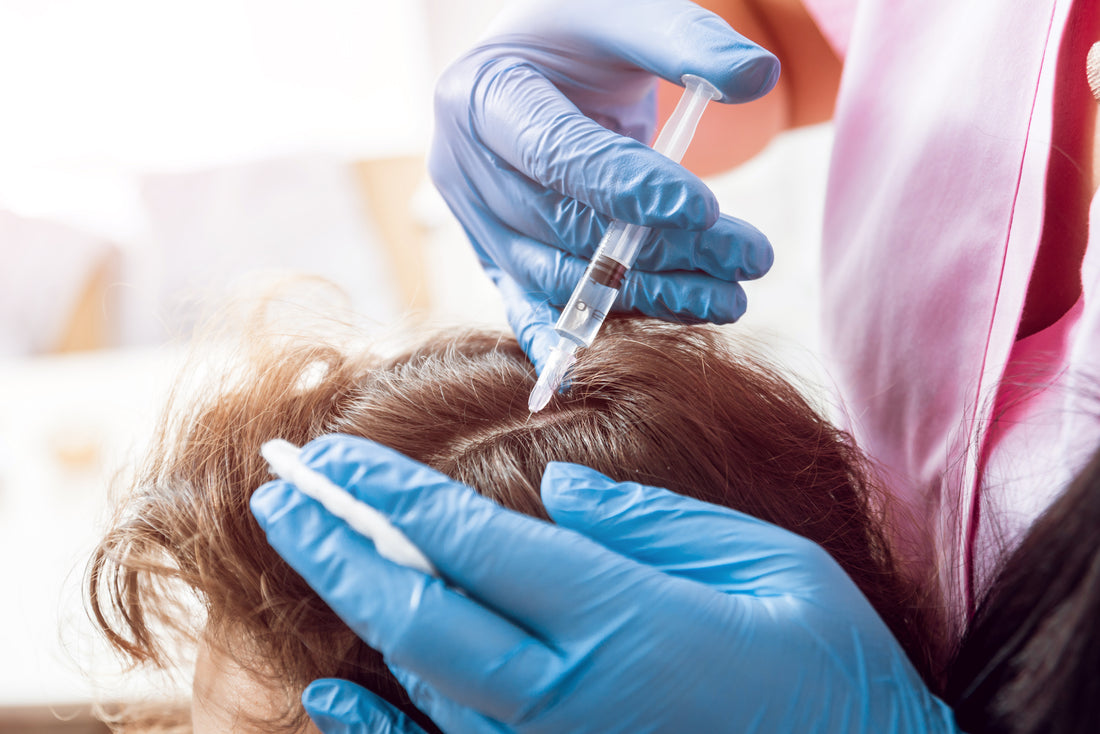
PRP THERAPY
Share
BEFORE WE BEGIN...
The information provided in this article is for information purposes only and should not be considered as a substitute for medical advice. Please read our disclaimer at the bottom of this page for more information.
INTRODUCTION
Next in our treatment series we cover Platelet-Rich Plasma (PRP) therapy.
You may have heard of the ‘Vampire Facial’ over the last few years but PRP therapy treatments have been widely used since the 1980’s for musculoskeletal injury problems such as those to your tendons and ligaments, along with muscle damage. It is still widely used today in a variety of applications from dentistry to orthopedics and even as part of a multifaceted approach to treat hair loss.
This non-surgical procedure is considered relatively straightforward and minimally invasive. Coupled with the fact it is conducted under local anaesthetic and it is easy to see why it is gaining popularity. However, can this play a safe and effective role in the treatment of hair loss? Let’s find out more!
WHAT IS PRP?
Broadly speaking, PRP therapy is a three step procedure involving blood being drawn from your body (normally your arm) before being placed in a special machine called a centrifuge, and then injected into your scalp.
This centrifuge is designed to rapidly spin fluids, such as blood, and separate them into various layers based on their densities. In PRP Therapy, the extracted blood, which is made up of core components, separates into layers such as red blood cells and plasma, which contains platelets rich in growth factors.
In theory, it is believed that the platelet rich plasma may stimulate a group of cells, called the dermal papilla, which play a critical role in hair growth according to sources such as the Harvard Medical School.
The research behind this points to PRP being a useful tool against Androgenetic Alopecia, but with limited studies conducted on other forms of hair loss. The research also suggests that this appears to provide better results in the early stages of hair loss.
HOW DOES PRP WORK?
As we just mentioned, it is thought that the key to PRP Therapy is through a critical component in your blood - platelets. So, at this point it is probably worth touching on the role that platelets play in your body and hair so we can understand how it is believed to work.
WHAT ARE PLATELETS?
Well, platelets are one of four primary components of blood, with the others being red blood cells, white blood cells, and plasma. Why platelets are considered so important, not only in wound healing but as a hair loss treatment, is due to their well documented role in cell growth and regeneration (a number of articles can be found on the NCBI’s National Library of Medicine). While the blood has two types of plasma, it is the “platelet-rich” variant that is most important as this generally about five times more concentrated in PRP than in regular blood, as cited by the Harvard Medical School, and these platelets release specialized proteins called growth factors.
Growth factors are essentially hormones that regulate things like cell division, cell growth, the formation of blood vessels and assist in wound healing. Platelets send out numerous types of growth factors, and each one triggers a specific response in the nearby cells. Looking at their role in hair loss, it is hypothesised that certain growth factors may act on stem cells found in the bulge area of the follicle, as referenced in a 2014 study published in the US National Library of Medicine National Institutes of Health, which in turn is believed to stimulate the development of new follicles.
The success of PRP Therapy, and your suitability for the procedure, will be based on how much of this platelet-rich plasma you have.
THE PROCEDURE
So, back to the actual process of PRP...
Just to recap we have already mentioned that the first step is for blood to be taken from your body. The second step will see your blood placed into a centrifuge where the components are separated to get the platelet rich plasma.
As the components of the blood have different densities, the rapid movement of the centrifuge allows the more dense red blood cells to sink to the bottom of the test tube. After approx 10-15 minutes the blood would have separated into 3 layers:
- Platelet-Poor Plasma
- Platelet-Rich Plasma
- Red Blood Cells
The layer containing the platelet rich plasma, the one packed full of growth factors, is then drawn into a syringe and injected into the areas of the scalp affected by the hair loss.

DOES IT WORK?
As we have discussed, there are various studies surrounding the role of PRP as a treatment for Androgenetic Alopecia and one such published back in 2014 titled - Platelet-Rich Plasma in Androgenic Alopecia: Myth or an Effective Tool - concluded that PRP was a ‘feasible treatment option for androgenic alopecia’.
This is backed by another study in 2015 titled -The Effect of Platelet-Rich Plasma in Hair Regrowth: A Randomized Placebo-Controlled Trial - it suggests ‘that the injection of PRP preparations has a positive therapeutic effect on male androgenic alopecia’.
However, a more recent study suggests that PRP may work best when it is combined with other treatments for AGA, such as Minoxidil or Finasteride, so this type of therapy may yield it’s best results as part of a multifaceted treatment regime.
As with any treatment, results are individual and not guaranteed to work for everyone and not everyone is suitable for PRP Therapy. You will need to discuss any existing medical conditions you may have with your doctor or surgeon first.
PRP THERAPY: HAIR TRANSPLANTS
As we mentioned, PRP may well work best when combined with treatments such as Minoxidil and Finasteride, however, another treatment option which may benefit with this partnership is hair transplantation.
A number of hair transplant clinics now offer PRP Therapy as part of their treatment options, with clinics such as the Cooley Hair Centre citing that PRP Therapy is used to complement hair transplant surgery due to the role this is believed to play in accelerating healing and new hair growth post transplant.
Some surgeons, such as Dr. Richard Moore, have been noted in supporting the use of PRP Therapy after FUE transplants (you can read more on this in our Hair Transplant Article) to help promote hair growth and vascular supply to the scalp. Others such as Dr Tory Torgeson believe that patients who combine this can experience faster recovery times, less shedding and a higher retention of transplanted grafts.
There have also been limited studies on the subject, however, a 2016 study concluded that PRP therapy during hair transplant surgery was ‘beneficial in giving faster density, reducing the catagen loss of transplanted hair, recovering the skin faster and activating dormant follicles in FUE transplant subjects’.
WHAT DOES IT COST?
PRP costs vary a lot depending on the practitioner but expect to spend up around £400 per session or £1,200 for your initial cycle as you will likely need 3 sessions, 4-6 weeks apart.
HOW LONG DO RESULTS LAST?
Once your initial course has completed, results should expect to last approx 12 -18 months according to clinics such as the Farjo Hair Clinic and Harley Street Medical Doctors and a number of clinics suggest you should see the results of PRP anywhere from 3 weeks to 3 months after your first session.
However, as we mentioned earlier, PRP is not a long-term solution on its own.
After your initial course of PRP Therapy, further ‘maintenance’ sessions are required. The frequency of these vary, with some surgeons recommending these maintenance sessions every 4-6 months with others believing that one every 12 months will be sufficient. Whichever frequency, this will be an additional ongoing cost for you to consider too.
WHAT ARE THE POSSIBLE SIDE EFFECTS?
While PRP is considered fairly safe, with some studies noting that PRP provides positive effects without major adverse side effects, your scalp will be subjected to multiple injections. Here are some of the more common side effects that are referenced;
- Local infection at the site of injection
- Pain at the injection sites
- Mild pinpoint bleeding
- Headaches
- Swelling on the scalp
- Itchy scalp
Clinics, such as The Maitland Clinic, report that after your treatment most patients will return to work the next day.
HOW CAN NANOGEN HAIR FIBRES HELP?
As with many of the treatment options we have covered, Nanogen Hair Fibres can really help to provide additional concealment while PRP Therapy takes effect, especially in the early months after your initial sessions. They are also always on hand in the event that PRP Therapy does not provide you with the results you are expecting,
CONCLUSION
From the research on offer, PRP appears to be a useful addition to the hair loss treatments available as a way to increase hair bulk and in tandem with non-surgical options such as Minoxidil and Finasteride along with hair transplants.
While PRP Therapy has shown promising results from the limited research available, these have been conducted on small numbers of participants so doubts could be raised about its suitability as a stand alone treatment.
FURTHER READING
Why not check out our other articles;
DISCLAIMER:
While our aim is to provide you with up-to-date and relevant information, drugs affect each person differently. As such we can not guarantee that this information includes all possible side effects and this information is not a substitute for medical advice. Always discuss treatment options and possible side effects with a healthcare professional who knows your specific medical history.




